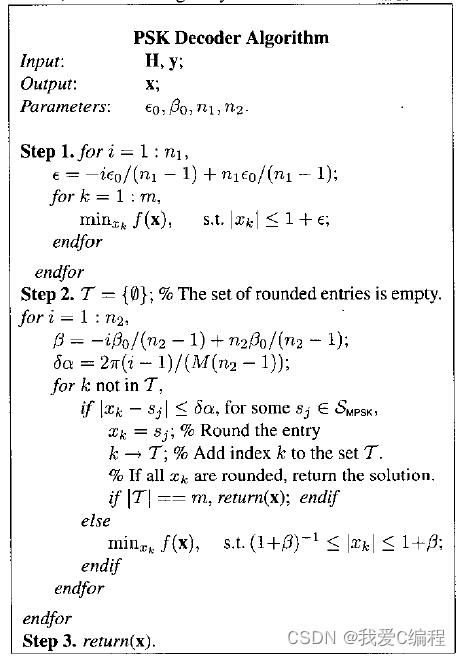目录
1.算法描述
《An efficient quasi-maximum likelihood decoder for PSK signal》
《[1] Luo Z Q , Luo X , Kisialiou M . An efficient quasi-maximum likelihood decoder for PSK signals[C]// IEEE. IEEE, 2003.》
Since exact maximum likelihood (ML) detection is computationally intractable in general, approximate ML approaches are needed to reduce the computation time while maintaining low bit error rate (BER). In this work, we develop an efficient approximate ML decoder for constant modulus signals based on a simple nonlinear programming relaxation. Unlike the existing sphere decoder whose expected complexity is cubic in problem size and whose performance deteriorates with increasing problem size and noise level, our proposed new decoder enjoys a worst case quadratic complexity and scales gracefully with problem dimension and noise level. Our initial testing and analysis suggests that this new decoder is capable of delivering ML like BER performance for PSK signals while requiring substantially lower computational complexity. In this sense, our new decoder is similar to the sphere decoder which is an effective method for QAM signals.

这里,从论文的仿真图可知,我们所要做的主要工作就是本课题所使用的算法和球形译码的性能对比。球形译码的不是本文的研究内容,其主要参考文献3获得,这里不做介绍,这里我们重点介绍本文所研究的PSKD算法。
其中误码率,我们进行系统的误码率分析,而复杂度的对比,我们这里主要是统计仿真时间,然后反映其复杂度,注意,这里仿真时间和电脑的配置有关,配置牛逼,则仿真时间则越短,但是其复杂度的对比曲线基本变化趋势是不变的。
这里,我们主要根据

上述算法流程进行仿真。
2.仿真效果预览
matlab2022a仿真如下:



3.MATLAB核心程序
SNR = 1:8;
%统计无码数
Times = 500;
%m
Tm = 10;
%n
Rn = 10;
%仿真序列帧长度
data_Numbers = 300;
for i=1:length(SNR)
Bit_err(i) = 0;
Num_err = 0;
Numbers = 0; %误码率累加器
N0 = 10/(10^(SNR(i)/10));
while Num_err <= Times
Num_err
fprintf('SNR = %f\n', SNR(i));
%产生需要发送的随机数
Trans_data = round(rand(1,data_Numbers));
%BPSK
Trans_BPSK = 2*Trans_data-1;
%作为发送信源
MIMO_Tx(1,:) = Trans_BPSK;
for send_loop = 2:Tm
MIMO_Tx(send_loop,:) = MIMO_Tx(1,:);
end
%信道
H_Ray = (randn(Rn,Tm)+sqrt(-1)*randn(Rn,Tm))/sqrt(2);
H_Ray = abs(H_Ray);
%QUASI-ML PSK decoder算法
for k=1:data_Numbers
y = H_Ray*MIMO_Tx(:,k) + 2*N0*randn(size(H_Ray*MIMO_Tx(:,k)));
y = y/max(max(abs(y)));
%%%%%%%%%%%%%%%%%%%%%%%%%%%%%%%%%%%%%%%%%%%%%%%%%%%%%%%%%%%%%%%%%%%%%%%%%%%%%
e0 = 0.5;
beta0 = 0.4;
n1 = 10;
n2 = 10;
ee = zeros(n1,1);
%STEP1
for i1 = 1:n1
ee(i1) = -i1*e0/(n1-1) + n1*e0/(n1-1);
x1s = [-1-ee(i1)+(2+2*ee(i1))/Tm:(2+2*ee(i1))/Tm:1+ee(i1)];
for k1 = 1:Tm
x1 = x1s(k1)*ones(Tm,1);
f1(k1) = x1'*H_Ray'*H_Ray*x1 - y'*H_Ray*x1 - x1'*H_Ray'*y + y'*y;
end
[g1(i1),xk1(i1)] = min(f1);
end
[g11,xk11] = min(g1);
XK1 = y(xk1(xk11));
%%%%%%%%%%%%%%%%%%%%%%%%%%%%%%%%%%%%%%%%%%%%%%%%%%%%%%%%%%%%%%%%%%%%%%%%%%%%%
%STEP2
M = 64;
for i2 = 1:n2
beta(i2) = -i1*beta0/(n2-1) + n2*e0/(n2-1);
deltaa(i2) = 2*pi*(i2-1)/(M*(n2-1));
x2s = [-1-beta(i2)+(2+2*beta(i2))/Tm:(2+2*beta(i2))/Tm:1+beta(i2)];
for k2 = 1:Tm
x2 = x2s(k2)*ones(Tm,1);
f2(i2,k2) = x2'*H_Ray'*H_Ray*x2 - y'*H_Ray*x2 - x2'*H_Ray'*y + y'*y;
end
end
for k2 = 1:Tm
[g2,xk2] = min(f2(:,k2));
XK2(k2) = y(xk2);
end
%%%%%%%%%%%%%%%%%%%%%%%%%%%%%%%%%%%%%%%%%%%%%%%%%%%%%%%%%%%%%%%%%%%%%%%%%%%%%
%STEP3
a5(:,k) = XK2;
end
%接收
MIMO_Rx = a5;
MIMO_Rx2 = ones(1,Tm)*MIMO_Rx(:,:);
Rec_data =(sign(MIMO_Rx2)+1)/2;
[nberr,rat] = biterr(Trans_data,Rec_data);
Num_err = Num_err+nberr;
Numbers = Numbers+1;
end
Bit_err(i)=Num_err/(data_Numbers*Numbers);
end
figure;
semilogy(SNR,Bit_err,'o-r');
xlabel('SNR(dB)');
ylabel('BER');
grid on;
% save BPSK_10_err.mat SNR Bit_err
01_108m4.完整MATLAB
V






















 1460
1460











 被折叠的 条评论
为什么被折叠?
被折叠的 条评论
为什么被折叠?










